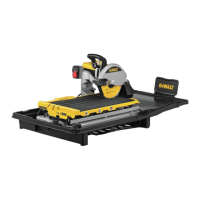7
ENGLISH
Locking the Cutting Cart (Fig. Z)
There are three locking position for thecart.
Move the cart to the lock position and lock the cart by pushing the pin
38
into a hole in
therail.
Types of Cuts
WARNING: Do not make freehandcuts.
Always do a practice run to acquaint yourself with the path of the cutting wheel. Practice on
a scrap tile to ensure that you are comfortable with the feel of the cutting operation. Push the
cart past the cutting wheel before turning the sawon.
Straight Cuts (Fig. Q, AA, BB)
1. Using a marker or grease pencil, mark the area to be cut ontile.
2. Place the tile on the cutting cart against the cutting cart fence
36
and align your mark
with thecuttingwheel.
3. Pull the on/off switch up to turn the saw on and wait for the cutting wheel to be
completely covered withwater.
4. Ease the cutting cart toward the cutting wheel then slowly feed the tile into the cutting
wheel. Continue pushing until the cutting wheel cuts completely through thetile.
NOTE: The wheel cover can be rotated up to help align the line on the tile with the cutting
wheel. Loosen the bolt
54
with the wrench
25
and shown in Fig BB and rotate the
wheelcover.
5. Turn off thesaw.
Diagonal Cuts (Fig. Q)
Diagonal cuts are also referred to as “long point to long point cuts.”
1. Align the point of the tile closest to the cutting cart fence
36
with the cut indicator
39
.
2. Align the front of the tile to the cuttingwheel.
3. Turn the saw on and make thecut.
4. Turn off thesaw.
L-Cuts (Fig. Q)
An L-cut is a section that is removed from a piece of tile and is used when cutting a piece of
tile to fit in a corner of a cabinet or piece of trimmolding.
1. Outline the area to be cut on both sides of thetile.
2. Align the tile to the cutting cart fence
36
and make the cut far enough into the tile
withoutovercutting.
3. Make a cut on the other mark on the tile withoutovercutting.
4. Turn the tile over and make the cut along one of the outlines, but this time an overcut can
occur without damaging the exposed surface of the tile due to the radius of the cutting
wheel. Overcut the other line and the cut piece should be separate from the rest of thetile.
5. Turn off thesaw.
Plunge Cuts (Fig. A, M)
Plunge cuts are utilized when removing the center of a piece of tile for electrical outlets and
for making cuts for air conditionerregisters.
1. Outline the area to be cut on both sides of thetile.
2. Release the cutting head by loosening the head lock knob
4
.
3. Adjust the depth of cut knob
40
in the rear of the cutting wheel guard to prevent the
cutting wheel from traveling too deep and cutting into the cutting cart. Always do a dry or
practice run to acquaint yourself with the path of the cutting wheel. Practice on a scrap tile
to ensure that you are comfortable with the feel of the cuttingoperation.
4. Place the tile on the cutting cart with the finished side facingup.
5. Align the mark with the cuttingwheel.
6. Turn the saw on. With one hand on the plunge handle
3
and one hand on the tile,
keeping both hands at a safe distance from the cutting wheel, lower the head of the saw
slowly into the tile. Cut into the tile up to the edge of the mark withoutovercutting.
7. Repeat the process on each outline withoutovercutting.
8. Turn the tile over. Repeat steps 2 and 3, overcutting along the lines which will allow the
piece to fallout.
NOTE: The corners may need to be trimmed with tile nippers (not included with thesaw).
9. Turn off thesaw.
Miter Cuts: 22.5° and 45° (Fig, A, M, P, Q)
Miter cuts are used for cutting outside and inside corners on tile, decorative chair rail and
basemolding.
The cutting head of the saw is adjustable to three positions: 0°, 22.5° or 45°. The three
grooves
37
in the cutting cart allow for the cutting head to be set at the three settings
without cutting into the cutting cart assembly
11
.
Making a Cut (Fig. A)
Verify the proper alignment of the cutting cart and cutting wheel before turning the saw on.
Always keep hands away from thecuttingwheel.
1. Lift the On/Off switch
1
to turn the saw on. Wait until the stream of water completely
covers thecuttingwheel.
NOTE: Cutting tile without water will damage thecuttingwheel.
2. Ease the cutting cart toward the cutting wheel then slowly feed the tile into the cutting
wheel. Continue pushing until the cutting wheel cuts completely through thetile.
3. Turn the saw off by pushing the On/Off switch
1
down.
4. After the cutting wheel stops, remove the tile and remnant from the cuttingcart.
Fig. Y
Unlock Position
(Remove cart)
Position 1 Position 2
Cutting Cart Stop Knob (Fig. A, Y)
The cutting cart stop knob
18
allows the user to bring the cutting cart assembly
11
back to
the same point each time. To set the position, LIFT UP AND ROTATE the cutting cart stop
knob and slide the cutting cart back until it stops. It can be set to three different positions
based on the userspreference.
• Unlock Position: Remove & install cutting cart
• Position 1: 36" (90cm) cut capacity. Cart extends past theframe.
• Position 2: 18" (45cm) cut capacity. Cart stops at the edge of theframe.
Fig. X
34
17
Fig. W
34
Fig. V
34
Fig. Z
38

